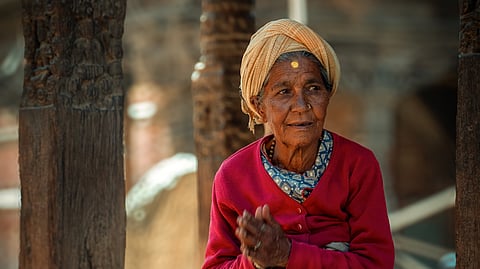From Kathmandu Chaos to Mustang's Serenity: A Traveller's Tale
The flight from Bangalore to Kathmandu was uneventful, save for the constant chatter of a fellow traveler, an elderly Nepali man who spoke of his hometown in Mustang with a mix of nostalgia and pride. "You will see," he said, "it is like stepping into another time." I smiled, only half-believing him, unaware that his words would soon ring true.
Kathmandu was chaos, an explosion of color, sound, and movement. The streets smelled of incense, freshly fried momos, and damp earth. Thamel, with its winding alleys and trekking shops, seemed an unavoidable maze for travelers. I spent the night at a modest guesthouse, where the owner, a wiry man with sun-darkened skin, sized me up before asking, "Mustang?" I nodded. "Ah, the road is not easy. But worth it. You will see."
The journey to Pokhara was long but scenic, the Prithvi Highway hugging the banks of the Trishuli River. In the bus, a mother cradled her sleeping child while an old man chewed betel nut, his fingers stained red. Outside, the world blurred past—rice terraces, roadside tea stalls, children waving at the passing vehicles. By the time I reached Pokhara, the sky had turned golden, the Annapurna range glowing in the fading sunlight. The lake shimmered, reflecting the flickering lamps of the boats that dotted its surface. I met a group of bikers from Delhi who were also heading to Mustang, their Royal Enfields parked in a neat row. "The road is tough," one of them warned. "But man, it’s beautiful."
The next morning, I set off towards Jomsom in a battered jeep. The road was dust and stone, climbing higher into the mountains. We stopped at a roadside shack for tea, where a young boy named Sonam served us with practiced ease. "Do you go to school?" I asked. He shook his head. "Tourists come, I work." His voice was matter-of-fact, devoid of complaint. The simplicity of his words stayed with me as we continued our ascent.
The Kali Gandaki Gorge opened up before us, its sheer cliffs towering above the rushing river. The driver, a man of few words, smoked quietly as he maneuvered the narrow paths. In Marpha, a picturesque village with whitewashed houses and apple orchards, an old woman sold dried apples from a basket. "For the road," she insisted, pressing a handful into my palm. The sweetness cut through the dust in my throat as we pressed on.
Jomsom was wind-swept, its streets lined with stone houses and prayer flags that fluttered furiously. I found a lodge where the owner, Tenzing, welcomed me with a steaming bowl of thukpa. "You will need your strength for the journey ahead," he said, gesturing towards the rugged peaks in the distance. I met a French couple, trekkers who had been in Nepal for months. "Upper Mustang is unlike anything," they assured me. "Like Tibet before it changed."
The next leg of the journey was on foot. The land became harsher, the air thinner. I walked alongside a trader named Dorje, who led a mule laden with supplies. "In the old days, we carried salt from Tibet," he told me, his voice lost in the wind. "Now, fewer traders, more tourists." At night, I stayed in a small teahouse where a young girl, no more than twelve, tended to the fire. "My mother is in Kathmandu," she said, stirring a pot of lentils. "I take care of the travelers."
As the days passed, the landscape grew more surreal. The wind sculpted the mountains into shapes both strange and mesmerizing. Yak herders moved in slow, rhythmic steps, their animals laden with supplies. At one point, a storm forced us to seek shelter in a cave. An elderly monk sat there in silence, his hands wrapped around a wooden prayer bead. "The mountains decide," he murmured. "Not us."
The final stretch to Lo Manthang was grueling. The trail wound through canyons, past caves that had once housed monks. A group of young boys ran past, kicking a faded football, their laughter lost in the wind. At one point, an elderly man, his face lined with years of mountain life, stopped me. "Drink this," he said, handing me a cup of butter tea. The taste was foreign, rich, slightly salty, but it warmed me from the inside. He watched me sip, then nodded approvingly. "You are almost there."
And then, just like that, I was. Lo Manthang appeared, a walled city in the middle of an ancient desert. The houses were mud-brick, the streets quiet, the air thick with history. Monks in maroon robes walked by, spinning prayer wheels. A young boy, his cheeks wind-burned, ran past me, laughing. I stood there, letting the weight of the journey settle.
The next morning, I wandered the city. The ancient palace stood in the center, its walls cracked but proud. I met a painter, his hands stained with pigments, working on a thangka. "This art is old," he said. "Older than me, older than my father." In a small monastery, I listened to the rhythmic chanting of monks. The air smelled of butter lamps and incense, thick and sacred.
As evening fell, I sat atop a ridge, watching the sun cast long shadows over the valley. A herder joined me, his face weathered but kind. "The wind carries stories here," he said. "Sometimes they are ours. Sometimes they belong to those before us."
I had stepped into another time, just as the old man on the flight had promised. And he had been right—worth it, every single step.
.png)


